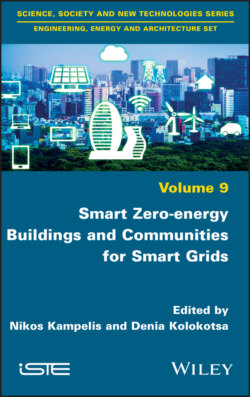Читать книгу Smart Zero-energy Buildings and Communities for Smart Grids - Группа авторов - Страница 18
1.3. Conclusion and future prospects
ОглавлениеSmart grids can be considered very promising for the energy and building environment industry due to the fact that they create a physical proximity between consumers and micro energy sources that help increase consumer awareness toward a more rational use of energy.
Moreover, smart grids can offer new opportunities for the reduction of gas emissions by creating technical conditions that increase the connection of devices and renewable energy resources at a low voltage level.
In addition, smart grids in the building sector offer a great opportunity for improving the power quality and reliability of energy sources due to the fact that it offers decentralization of supply, better supply and demand matching, reduction of transmission losses and minimization of downtimes. Thus, energy investments can be shifted from the expansion of transmission and large-scale generation systems to the energy efficiency in the building sector, that is, improving building fabric, increasing green infrastructure in the community, and improving indoor and outdoor environment interaction by using landscape solutions.
In addition, the widespread application of modular micro generation sources on a community level may contribute to the reduction of the energy price in the power market. Further, price reduction may be achieved by optimizing micro-generation operation and performing building load forecasting, which is possible due to the available data from the metering process. As a result, the smart grids can be viewed as aggregators of buildings, consumers and communities that will be empowered with better prices and valuable opportunities.
In order to reach the aforementioned goals, several challenges and drawbacks should be overcome. Technical challenges are mainly related to lack of experience, knowledge and competence necessary to successfully operate the micro generation energy sources as well as to interact with the building’s occupants. These aspects require extensive research efforts with an interdisciplinary perspective that will examine smart grids’ real time management, protection and control. Simultaneously, the role of the end users and building occupants should be enhanced and successfully incorporated. The Internet of Things can play a significant role in this direction as it can support raising awareness of end users and can provide user friendly applications for demand response and load management capabilities. In order to achieve this, specific telecommunication in infrastructures as well as open communication protocols should be provided to help manage, operate and control buildings within smart grids.
Another significant challenge is related to the increased initial installation cost which constitutes a great disadvantage. Specific policies and incentives should be provided by the governmental bodies to encourage investment in order to reach national carbon reduction goals.
Finally, significant effort should be put in the development of standards concerning the operational characteristics, the power quality, real time optimization and overall management.
Chapter written by Denia KOLOKOTSA.
